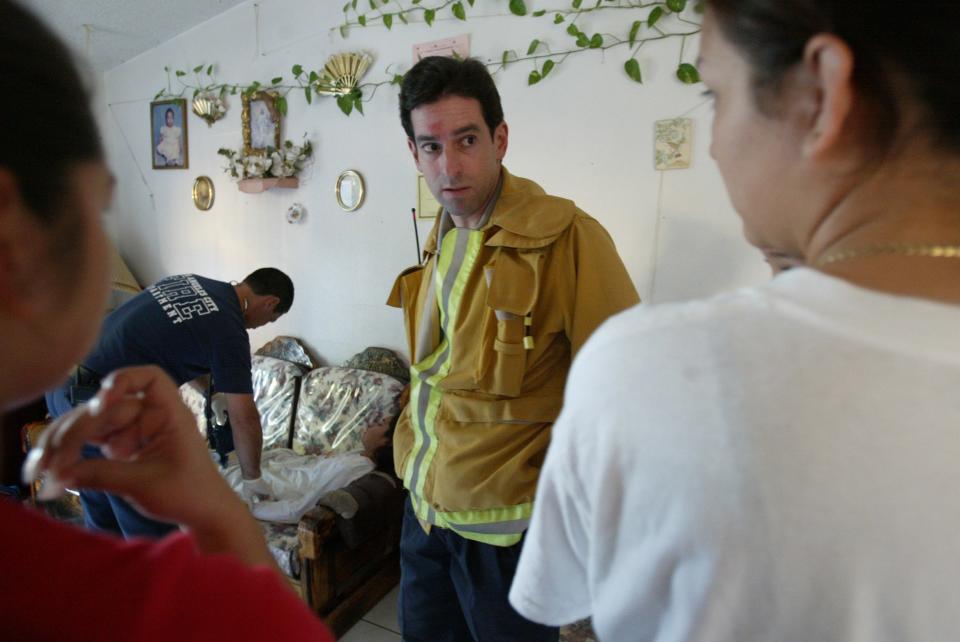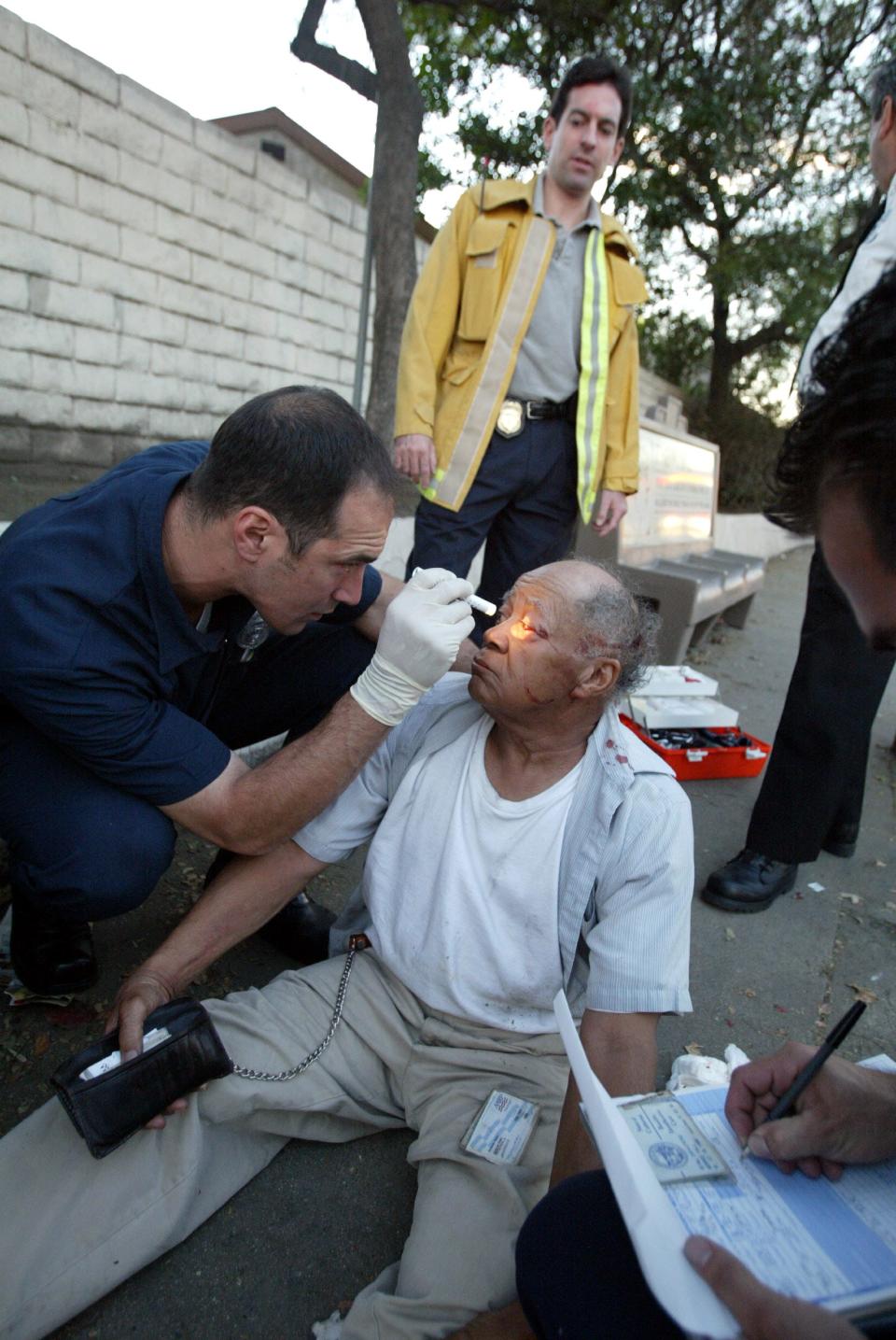From the archives | Special report: Sluggish responses to emergencies let patients die
This story originally published on July 29, 2003. It is being republished as part of the commemoration of USA TODAY's 40th anniversary on Sept. 15, 2022.
LOS ANGELES -- When baggage handler Andrew Redyk, 64, collapsed on the job at Los Angeles International Airport, his co-workers leaped into action. One called for help. Another did CPR.
The Los Angeles Fire Department sent a nearby fire engine and an ambulance, which arrived at the airport in six and seven minutes, respectively. Officially, their response time was quick enough to save Redyk.
In truth, almost half an hour passed before rescuers actually reached Redyk. He died.
This official deception is not unusual. Los Angeles is one of many cities that routinely lie to themselves about their true response times to medical emergencies. The illusion allows them to claim success, but the result is needless deaths.
There is no nationwide standard for measuring emergency response times. A USA TODAY study of the 50 biggest U.S. cities finds that most report only the slice of the response that looks most favorable: the time it takes for the emergency crew to drive to the scene. Often that is just a fraction of the time between the call for help and the arrival of rescuers at the victim's side.

Yet most cities base quality-control decisions on these official response times, which are misleading and incomplete. As a result, attempts to improve survival rates fail.
More than 1,000 "saveable" lives are lost needlessly each year in the nation's biggest cities because of inefficiencies in the cities' emergency medical systems, USA TODAY's investigation found, and at the root of these inefficiencies in many cases is the simple matter of counting seconds. Cities that rely on these imprecise response times leave precious minutes unaccounted for -- minutes that are lost as the call for help is routed through a busy dispatch center or as crews park and make their way to the victim, perhaps through a tall building, a shopping mall or an airport terminal.
The 18-month investigation -- which included a survey of emergency medical directors, analyses of dispatch data, extensive site visits and interviews with city officials, firefighters, paramedics and victims' families -- found that the way cities measure their response time to the most critical calls makes a difference in how many lives are saved. Those that save the most lives often have improved their performance by first changing the way they measure response times to life-or-death calls, then making changes to their systems based on weaknesses revealed by those measurements.
On calls involving sudden cardiac arrest -- the truest measure of emergency medical performance -- these cities have focused on response time from the victim's point of view: How long after 911 is called does help reach the patient and deliver lifesaving care?
New research from the Mayo Clinic shows that this type of patient -- one whose heart has short-circuited and has been thrown into a chaotic condition known as ventricular fibrillation -- has six minutes to live. A shock with a defibrillator within that time usually will restore the heart's rhythm. Even if the victim goes an additional minute without a normal heartbeat, he can survive if paramedics restore his breathing and administer key drugs.
But Redyk was kept waiting for 25 minutes. He had no chance.
According to news reports confirmed by Los Angeles' EMS medical director, the delay was caused by confusion, beginning with a misunderstanding between the caller and the dispatcher. When emergency crews entered the airport's baggage-claim area, Redyk was nowhere to be found. By the time rescuers determined that he had collapsed in a baggage room beneath them, and by the time they drove around the terminal, onto the airfield and to a ground-level entrance, it was too late.
The official response time was still reported as six minutes.
6% to 10% are saved
Deaths such as Redyk's are far more common in some cities than in others. Emergency medical systems in a majority of the nation's 50 largest cities save an estimated 6% to 10% of the victims of sudden cardiac arrest who realistically could be saved, which is the national average. But if all major cities followed the steps taken by Seattle, Boston, Oklahoma City, Tulsa and a few others that measure the truer response time, they could raise the survival rate to 20% or more, and about 1,000 more lives would be saved.
Nationwide, however, the record is not encouraging.
USA TODAY's analysis shows:
* Few cities know exactly how long their emergency crews take to reach cardiac arrest victims, and most are selective about how they portray their performance. Only nine of the 50 largest cities track their response times precisely enough to know how often emergency crews reach the victims of cardiac arrest within six minutes.
* Most other U.S. cities don't know their response times, refuse to disclose them or use imprecise measures that are meaningless in determining whether emergency crews reach victims in time to save them. This situation persists even though research clearly has shown that precise measuring improves performance and saves lives. Houston, for example, went from a near-zero survival rate for sudden cardiac arrest to 21% after it started to measure and fix problems that became clear.
Emergency officials acknowledge that more precise measures are needed. "Response times are deceiving," says Harold Shaitberger, president of the International Association of Fire Fighters. "An important factor is not only how quickly paramedics arrive at the scene, but how quickly they begin administering treatment."
Marc Eckstein, the Los Angeles Fire Department's medical director, agrees. "If your house is on fire, do you want to know the time it takes for them to get to the scene or the time it takes to squirt water?" he says. "It's time to mitigation. . . . Doing it the way we do it only makes pretty statistics."
The nation's emergency medical services are lagging at a time when science is leaping ahead, zeroing in on the exact moment between life and death. Medical experts are beginning to understand just how crucial a minute -- even seconds -- can be in emergency response.

Some cities have embraced the time challenge; they are using new technology and creative approaches to measure and shave seconds from their response times.
Rochester, Minn., home of the Mayo Clinic, has led the way. Over the past 12 years, Rochester, with Mayo's help, has measured -- to the second -- the "call-to-shock" time, from the time the 911 call comes in to the moment a shock is delivered to the patient.
Rochester knows, for example, that the people who are saved are shocked on average within 5 minutes 30 seconds. It also knows that those victims who were not saved were not shocked until, on average, 6 minutes 42 seconds after the 911 call was received. The Rochester data show that speed is so crucial that even less trained first responders who get to the victim with a defibrillator before the ambulance arrives can make the difference between life and death.
The city decided to give police officers defibrillators. Now, when an emergency dispatcher learns that a victim of cardiac arrest needs help, the call goes out with the same audible urgency of "an officer down." The police, who often have a head start because they are driving around on patrol, race the fire trucks to the scene.
Rochester police officers have been the first to shock 37 of the 73 people who were saved in the past 12 years. And the city has raised its sudden-cardiac-arrest survival rate from an already impressive 30% to 44%, about the same as Seattle, which has the highest rate in the nation among big cities at 45%.
Measure 'to the second'
The key to Rochester's success is no mystery, says Roger White, emergency medical services physician and anesthesiologist at the Mayo Clinic. "The data state it very clearly and unequivocally," he says. "We measure these times precisely to the second. A one-minute decrease in the call-to-shock time increases the odds of survival by 57%. . . . A three-minute reduction in call-to-shock time improves a victim's odds of survival almost fourfold. That is why we believe that constant evaluation of these intervals is critical. If we start to slip in our survival, the first place we are going to look is right here."
Rochester has taught other cities how to save lives.
When Miami-Dade County in Florida gave its police officers defibrillators, it slashed three minutes off the response time to cardiac arrest cases and raised its survival rate from 9% to 17%.
Other cities, including Washington, D.C., and New York, have tried to follow suit and have purchased defibrillators for police officers. But survival rates in those cities have yet to rise. Interviews with police and with instructors who conduct defibrillator education programs suggest that part of the problem has been resistance by police officers who, much like firefighters, object to the change in their role.
But Rochester police, inspired by the 37 lives they have saved, have for the most part accepted their expanded responsibilities. "This is our police culture," says Steven Johnston, deputy police chief.
Rochester is a relatively small city, too small to be included in USA TODAY's survey of big-city emergency medical systems.
Larger cities have tougher problems and are much more difficult to change. Still, some have been successful in instituting call-to- shock measurement, and the survey shows that, with a few exceptions, they are the cities with the highest survival rates.
In 2001, the year studied, USA TODAY found:
Seattle had a 45% survival rate, highest among the nation's 50 biggest cities. On average, Seattle's emergency crews took 8 minutes, 46 seconds to shock victims of sudden cardiac arrest. That time includes 90 seconds of CPR, in accordance with city protocol.
Oklahoma City had a 27% rate; average call-to-shock: 7 minutes, 36 seconds.
Tulsa, a 26% rate; average call-to-shock: 8 minutes, 48 seconds.
Six other cities measure call-to-shock but use less precise survival measures or could not provide other key information:
Columbus, Ohio, delivers 22% of victims to the hospital with a heartbeat but does not know how many survive; average call-to- shock: 7 minutes, 49 seconds.
Charlotte would not report its cardiac arrest survival rate, but it reported 6 minutes, 56 seconds call-to-shock average.
Oakland delivers 6% of cardiac arrest victims to the hospital with a heartbeat; average call-to-shock: 7 minutes.
Philadelphia delivers 5% of cardiac arrest patients to the hospital with a pulse; average call-to-shock: 6 minutes 50 seconds.
San Antonio, with a 9% survival rate, says call-to-shock is always within five minutes, but the city did not provide detailed data to support that claim.
Fresno's survival rate is unknown; average call-to-shock: 22 minutes 11 seconds.
At the lower end of the survival-rate spectrum, most cities don't measure call-to-shock time, or they refuse to say how long it takes them to reach people.
White says every city, big or small, could measure that key part of the response. "We believe the call-to-shock interval is something that can be objectively measured in every EMS system," he says. "It can provide a lot of insight into the likelihood of patient survival."
Unfortunately, says Shaitberger of the firefighters union, "very few fire departments and other EMS providers currently collect sufficient data to provide meaningful evaluations of their systems."
And without honest and precise appraisal, he and other emergency experts agree, the systems' weaknesses will remain hidden, and people will die needlessly.
Contributing: Rati Bishnoi, Anthony DeBarros, Mary Grote, In- Sung Yoo
This article originally appeared on USA TODAY: Emergency response times are a matter of life or death

